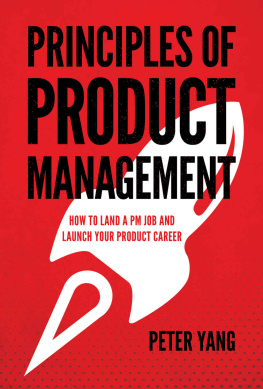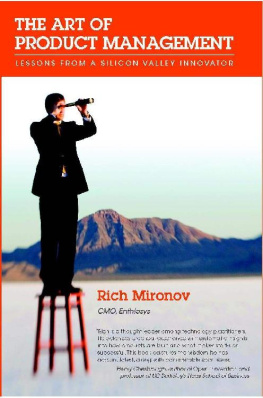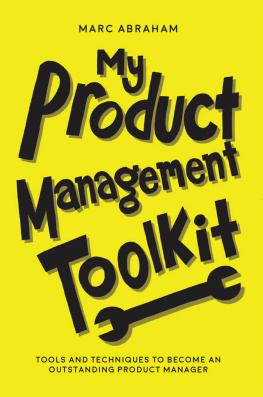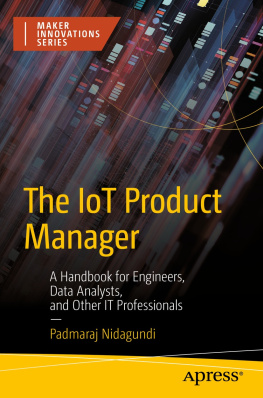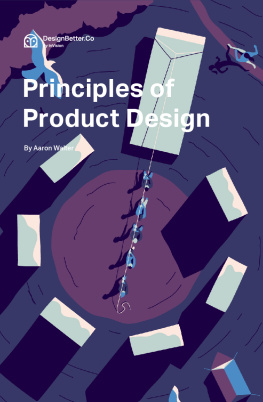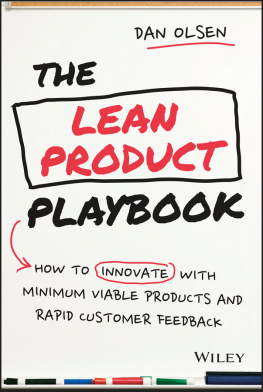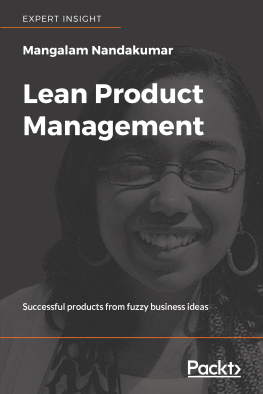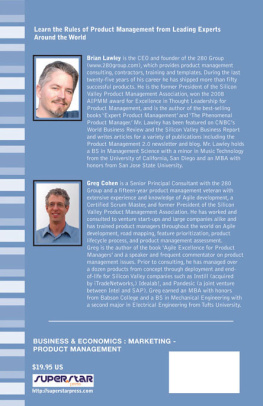Principles of Product Management
How to Land a PM Job and Launch Your Product Career
Peter Yang
To Jenny and Serena for creating lifes most meaningful memories.
Copyright 2019 by Peter Yang
All rights reserved.
No part of this book may be reproduced in any form or by any electronic or mechanical means, including information storage and retrieval systems, without written permission from the author, except for the use of brief quotations in a book review.
This book reflects the authors personal opinions, and do not represent the views of his employer.
Introduction
It was late Saturday afternoon at Facebooks Building 20, a sprawling open office below a rooftop garden. Instead of enjoying my weekend, I stood in a windowless room practicing product management interview questions. A year ago, I had failed to pass the companys PM interview loop as an internal transfer, but this time, I thought to myself, it would be different.
It would be different because I had spent the past year growing a new Facebook app to millions of users and winning the support of a product director on my team. I just needed to pass the interviews, and the long hours I spent preparing for them would be worth it.
Interview day arrived, and I came out of the first two interviews feeling confident. I had built a good rapport with my interviewers and answered their product and execution questions well. Now it was time for the behavioral interview. I was ready to talk about how I successfully scaled the new Facebook app, but the first question caught me off guard: Tell me about a time when you failed. I paused for a moment. Calm down, I thought to myself. You already prepared a good answer to this question. I gave my answer and shared more stories of failures and team conflicts with my interviewer over the next 45 minutes.
A few days passed with no response, and I began to feel anxious. Finally, on Friday afternoon, my product director stopped by my desk and asked if I had time to meet. We walked into that same windowless conference room. Peter, she said, You did well on two of the interviews, but your leadership examples werent great. Im afraid you didnt pass the loop. My heart sank. She tried to comfort me: I know you did a great job over the past six months, and the team loves working with you. You could always try again in another year.
That was years ago. Since then, Ive successfully transitioned to PM and launched many products at Amazon, Twitter, and other leading tech companies. Ive also pursued my passion for helping the next generation of PMs succeed through training programs and mentorship. Through my experience and conversations with others, Ive learned how tough it is to become a product manager and launch your product career.
This book is the guide that I wish I had when I first got started as a product manager. My goal is to give you the best practices on leading without authority, building a product, and landing a job all in one place.
What Do Product Managers Do?
Over the past decade, product management has become one of the most sought-after jobs in the U.S. Yet, few people outside the profession understand what PMs do. Those looking to enter the field often ask questions like "Do you need an MBA?", "Do you need to be technical?" and "Are product managers mini-CEOs?". To find answers, aspiring PMs need to sort through hundreds of blog posts or sign up for expensive boot camps.
A product managers job is to lead their team to build products that solve their customers most important problems. They do this by understanding the customer problem, identifying the right products to build, and executing with their team to bring the product to market.
How Is This Book Organized?
This book is a three-part, practical guide to help new and aspiring product managers land a PM job and launch their product career:
- Principles: Part one covers the leadership principles that PMs use to lead their team to solve customer problems. Hear stories about how I learned these principles, often the hard way.
- Product development: Part two covers how PMs at Facebook, Amazon, and other top companies build software products. Well walk through the end-to-end product development processfrom understanding the customer problem, to identifying the right product to build, to executing with your team to bring the product to market.
- Getting the job: Part three covers how you can land a PM job and prepare for interviews with practice questions and answers from Facebook, Google, and more. Well discuss the three most common types of PM interviewsproduct sense, execution, and behavioralin depth.
Throughout this book, Ive also included interviews with product leaders about their past successes and failures and what they wish they had known when they started their PM careers.
Lets start with the most important topic: the core principles that will help you lead without authority as a product manager.
What skills do great product managers have? Are they technical wizards, analytical machines, or product visionaries? These skills are important, but by far the most critical skill is leadership. Great product managers rely on their leadership skills every day to help their team ship products that solve customer problems.
Product managers build leadership skills through adversity. When your product fails to gain traction, when your team falls apart, or when your manager gives you tough feedback these are all opportunities to become a better PM and person.
Part one of this book outlines six principles that I think define great PMs and the stories that led me to them.
Your first project is to launch our new credit card marketplace. This project should be straightforward because we already defined the product and you just need to get it shipped.
In early 2019, I joined Credit Karma to grow the credit card businessthe largest revenue stream for the company. The team had worked for months on a complete redesign of the cards marketplace for logged out users, and my job was to get it out the door.
I caught up with my teammates who led the redesign. They shared that one of the goals was to make it easier for people to browse cards by category (e.g., travel cards, cash back cards, etc.). The team had conducted user research to identify this customer need, so I didnt question it. Over the next few weeks, I helped everyone get the new marketplace ready for launch.
Launch day arrived, and we celebrated with cupcakes. We rolled out the new marketplace to 50% of users as a test, and everyone felt confident that it would perform better than the old one.
Unfortunately, the numbers told a different story. As the days passed, a sense of dread crept over me. The new marketplace was performing worse, far worse. A week after launch, revenue was down 10% for the new marketplace compared to the old one.
I started making excuses in my head. I didnt define this product, so its not my fault. Im new to the team and dont want to rock the boat. Maybe if we wait another week, the numbers will improve.
But instead of making excuses or blaming others, I knew I had to take ownership. I told my manager, This is my fault, and I will fix this. Were looking at the numbers now to understand what went wrong. Over the next few days, I dove into the data and discussed the problem with my teammates. We realized that most people visited the marketplace after searching for best cards on Google. Unlike the people we recruited for user research, our real customers wanted to shop for cards right away. A quick look at our competitors websites confirmed our hypothesis: All of them displayed a list of best cards directly on their marketplace.

